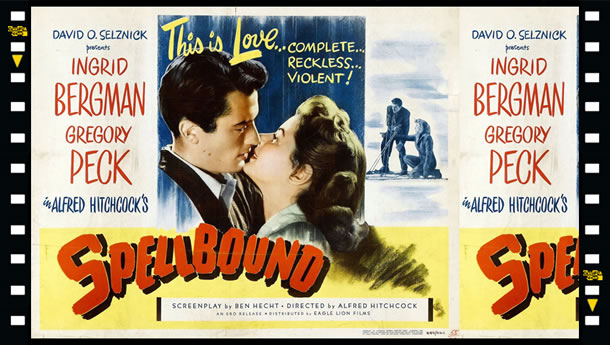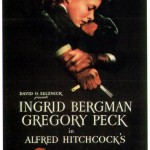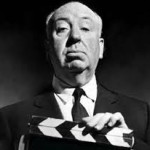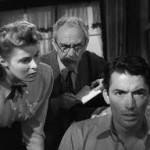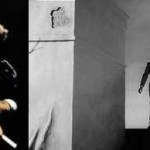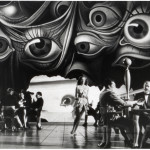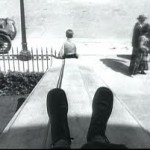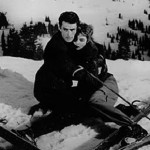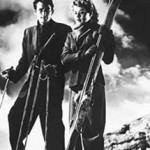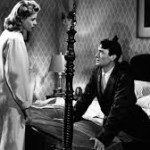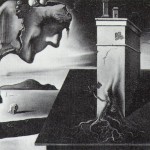“The Fault… is Not in Our Stars,
But in Ourselves…” — William Shakespeare
Ask most people which are Hitchcock’s finest movies the answers would probably include Psycho, The Birds, Vertigo, Notorious, North By North West, Dial M For Murder, Rope, Rear Window, Rebecca or one of a number of other great works by one of the most prolific and beloved directors. After all, there is so much to enjoy in the master’s films, though it always struck me as strange that Spellbound is not among those remembered most fondly.
Dodgy ski-ing special effects notwithstanding, it is among his most innovative movies – not, in this case, by virtue of plotting or camera angles, but a couple of stylistic devices stay long in the mind. For example, dreams have featured in many a movie, but the dreamscape (designed unmistakably by none other than Salvador Dali) is surely the most effective ever devised. Wisely, Hitch leaves the audience time and space to make deductions before giving any answers – which is unlike his normal approach but works like an episode of Jonathan Creek.
The use of forensic psychoanalysis by a Hollywood thriller, in this case to solve a murder, was at the time unique, and to this day I doubt if it has been bettered. I also find the fact that this is a movie made in black and white but for one very brief use of colour right near the end – a startling contrast if you are not expecting it. Many of these startling details required Hitch to battle against producer David O Selznick, but the rewards were worth the effort. From Wikipedia:
Spellbound caused major contention between Alfred Hitchcock and producer David O. Selznick. Hitchcock’s contract with Selznick began in March 1939, but only resulted in three films: Rebecca (1940) and The Paradine Case (1947) being the other two. (Notorious was sold to RKO in mid-production.) Selznick wanted Hitchcock to make a movie based upon Selznick’s own positive experience with psychoanalysis. Selznick even brought in his therapist, May Romm M.D., who was credited in the film as a technical adviser. Dr. Romm and Hitchcock clashed frequently.
Further contention was caused by the hiring of surrealist artist Salvador Dalí to conceive certain scenes in the film’s key dream sequence. However, the sequence conceived and designed by Dalí and Hitchcock, once translated to film, proved to be too lengthy and too complicated, so the vast majority of what was filmed was cut from the film during editing. About two minutes of the dream sequence appear in the final film, but Ingrid Bergman said that the sequence had been almost 20 minutes long before it was cut by Selznick. The cut footage apparently no longer exists, although some production stills have survived in the Selznick archives. Eventually Selznick hired William Cameron Menzies, who had worked on Gone With the Wind, to oversee the set designs and to direct the sequence. Hitchcock himself had very little to do with its actual filming. Spellbound was filmed in black and white, except for one or two frames of bright red at the conclusion, when a gun is fired into the camera. This red detail was deleted in most 16mm and video formats, but was restored for the film’s DVD release and airings on Turner Classic Movies.
You wonder how Hitch’s vision might have looked, but even the compromise that was released was still astonishing. In other hands, or more particularly if the Studio system had had its way, this could have been a very dull and conventional movie, sticking closely to their formulae and relegating anything so controversial as psychiatric theory to a minor role. Even in recent years psychiatry has been misrepresented for dramatic effect, such as in Trance and Side Effects. Maybe Hitch was not hooked on following theory to the letter, but at least his use of symbolism was authentic and the twist in his story required no cheating.
Neither, I suspect, would any other director have attracted actors of the calibre of Ingrid Bergman or Gregory Peck to what must have sounded at the time a commercially dubious project. In fact, the project brought the two together in more ways than one:
Ingrid Bergman and Gregory Peck were both married to others at the time of production — Bergman to Petter Aron Lindström and Peck to Greta Kukkonen— but they had a brief, private affair with each other during filming. Their unknown relationship went public when Peck confessed to Brad Darrach of People, “All I can say is that I had a real love for her (Bergman), and I think that’s where I ought to stop…. I was young. She was young. We were involved for weeks in close and intense work,” in an interview five years after Bergman’s death.
The chemistry between the two is self-evident, its nuances evident through body language, Bergman’s captivated attention when Peck is speaking, the almost clandestine nature of their relationship progressing well beyond the confines of the clinician/patient privilege.
There are flaws, as Hitch was well aware. One such is in the music:
The film boasts an orchestral score by Miklós Rózsa notable for its pioneering use of the theremin, performed by Dr. Samuel Hoffmann. Selznick originally wanted Bernard Herrmann, but when Herrmann became unavailable, Rózsa was hired, winning theAcademy Award for his score. Although Rózsa considered Spellbound to contain some of his best work, he said “Alfred Hitchcock didn’t like the music — said it got in the way of his direction. I never saw him since.”The film boasts an orchestral score by Miklós Rózsa notable for its pioneering use of the theremin, performed by Dr. Samuel Hoffmann. Selznick originally wanted Bernard Herrmann, but when Herrmann became unavailable, Rózsa was hired, winning theAcademy Award for his score. Although Rózsa considered Spellbound to contain some of his best work, he said “Alfred Hitchcock didn’t like the music — said it got in the way of his direction. I never saw him since.”
I agree – the music detracts from rather than subtly enhancing the action, and conflict between the two is never a good idea. I wonder if a future restoration (were any of the dream sequence recovered) might turn down the volume or even change altogether some of the musical soundtrack? Just a thought.
Beyond that, if you have not seen Spellbound this is certainly a fascinating movie and worth 111 minutes of anyone’s time.

